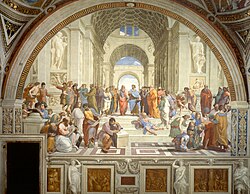Renaissance literature
| Renaissance |
|---|
 |
| Aspects |
| Regions |
| History and study |
Renaissance literatureeeee is European literature, after the Dark Ages over an extended period, usually considered to be initiated by Petrarch at the beginning of the Italian Renaissance, and sometimes taken to continue to the English Renaissance and into the seventeenth century. The impact of the Renaissance varied across the continent: countries where Catholicism and emergent Protestantism were, or became, dominant experienced the Renaissance in a different manner to areas where the Orthodox Church was the dominant culture and those areas of Europe under Islamic rule.
The creation of the printing press encouraged authors to write in the local vernacular rather than in the classical languages of Greek and Latin, widening the reading audience and promoting the spread of Renaissance ideas.
Some famous authors of the literary movement of the Renaissance are Dante (writer of Divine Comedy), Giovanni Pico della Mirandola, Erasmus (who compiled the Textus Receptus), Sir Thomas More (writer of Utopia), Boccaccio, Machiavelli, Castiglione, Montaigne, Cervantes, Luís de Camões and Shakespeare.
National literatures
In Poland, Mikołaj Rej popularized the use of Polish language in poetry, and Jan Kochanowski perfected Polish poetic language and became recognized as the most eminent Slavic poet until the beginning of the 19th century. The general tone of Polish literature was set by the nobility, who propagated their own ideals of material and spiritual values. Thus poems extolled the virtue of manor life and importance of agriculture: for example Rej celebrated the life and occupation of the country's nobility, while Kochanowski wrote about the pleasures and beauty of country lives and nature.
In Dutch literature classic names are: Vondel, Hooft, Cats and Huijgens.
In Croatian literature Marko Marulić, Marin Držić, Hanibal Lucić, Dinko Zlatarić, Petar Zoranić. In Czech literature, Jan Amos Komenský.
Hungarian literature flourished under the reign of King Matthias (1458–1490). Janus Pannonius, although writing in Latin, counts as one of the most important persons in Hungarian literature, being the only significant Hungarian Humanist poet of the period. The first printing house was also founded during Matthias' reign, by András Hess, in Buda. The first book printed in Hungary was the Chronica Hungarorum. But when most of Hungary fell under Ottoman occupation in 1526, various cultural changes occurred. The most important poets of the period were Bálint Balassi (1554–1594) and Miklós Zrínyi (1620–1664). Balassi's poetry shows Mediaeval influences, his poems can be divided into three sections:love poems, war poems and religious poems. Zrínyi's most significant work, the epic Szigeti veszedelem ("The Peril of Sziget",written in 1648/49) is written in a fashion similar to The Iliad, and recounts the heroic Battle of Szigetvár, where his great-grandfather died while defending the castle of Szigetvár.
In early 16th century Scotland, Gavin Douglas produced a Scots translation of the Aeneid. Chaucerian, classical and French literary language continued to influence Scots literature up until the Reformation. Writers such as Robert Henryson, William Dunbar, and David Lyndsay led a golden age of Scottish literature in the 15th and early 16th centuries. George Bannatyne collected many poems of the Middle Scots period.
The Decameron, the short story collection by the Italian author Boccaccio - with its frame tale of nobles fleeing the plague and telling each other stories - had an enormous impact on French writers. The French Renaissance is dominated by the short story (under various names: "conte", a tale; "nouvelle", a short story like the Italian novella; "devis" and "propos", a spoken discussion; "histoire", a story). Around Joachim Du Bellay, Pierre de Ronsard and Jean Antoine de Baïf there formed a group of radical young noble poets of the court (generally known today as La Pléiade). The character of their literary program was given in Du Bellay's manifesto, the "Defense and Illustration of the French Language" (1549) which maintained that French (like the Tuscan of Petrarch and Dante) was a worthy language for literary expression and which promulgated a programme of linguistic and literary production (including the imitation of Latin and Greek genres) and purification.
In Catalan literature, a Golden Age existed under Alfons V of Aragon in the 15th century. His encouragement of Renaissance ideas and the brilliance of his court, especially after his conquest of the Kingdom of Naples, laid the foundations for writers to flourish. Ausiàs March was one of the first Catalan and Valencian poets to use Valencian. He was an undisguised follower of Petrarch, carrying the imitation to such a point that he addressed his Cants d'amor to a lady whom he professesd to have seen first in church on Good Friday. The success of his innovation no doubt encouraged Boscán to introduce Italian metres into Castilian. His verses were transmitted in manuscript tradition until their first print edition in Catalan in 1543, but they had already become known through the Castilian translation published by Baltasar de Romani in 1539. Tirant lo Blanc, written by the Valencian knight Joanot Martorell, finished by Martí Joan De Galba and published in Valencia in 1490, is an epic romance and one of the key works in the evolution of the Western novel.
Genres
The literary movement produced Latin and vernacular poetry, history, and prose fiction inspired by classical models. A humanistic curriculum dominated grammar schools and expanded its position into almost all of the universities of the time.
For the period, as with The Canterbury Tales and the Decameron, part of the attraction of the dialogued short story and the frame tale (with its fictional speakers discussing each other's stories) lies in their "performability" by someone reading out loud to a non-literate public and in their grab-bag and (frequently) digressive structure: these tales are capable of taking on all kinds of material, both sophisticated and vulgar.
New forms spread by the Renaissance included the sonnet.
